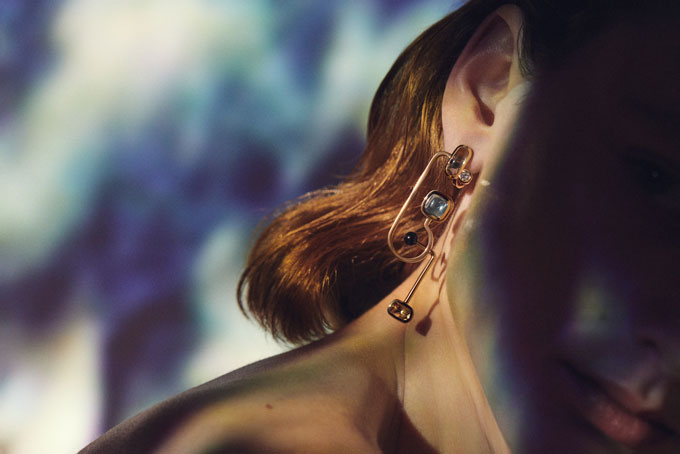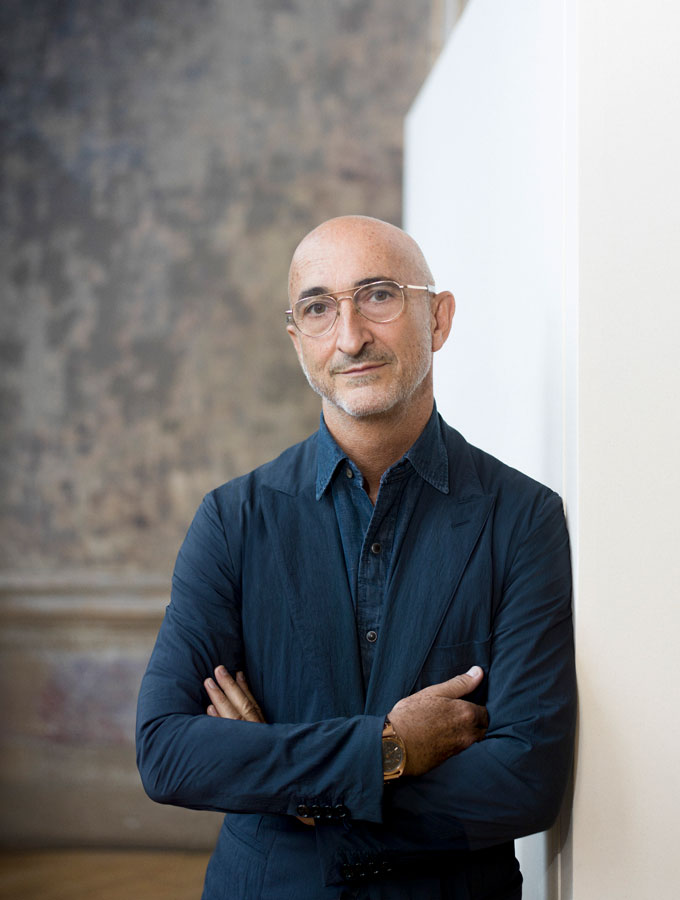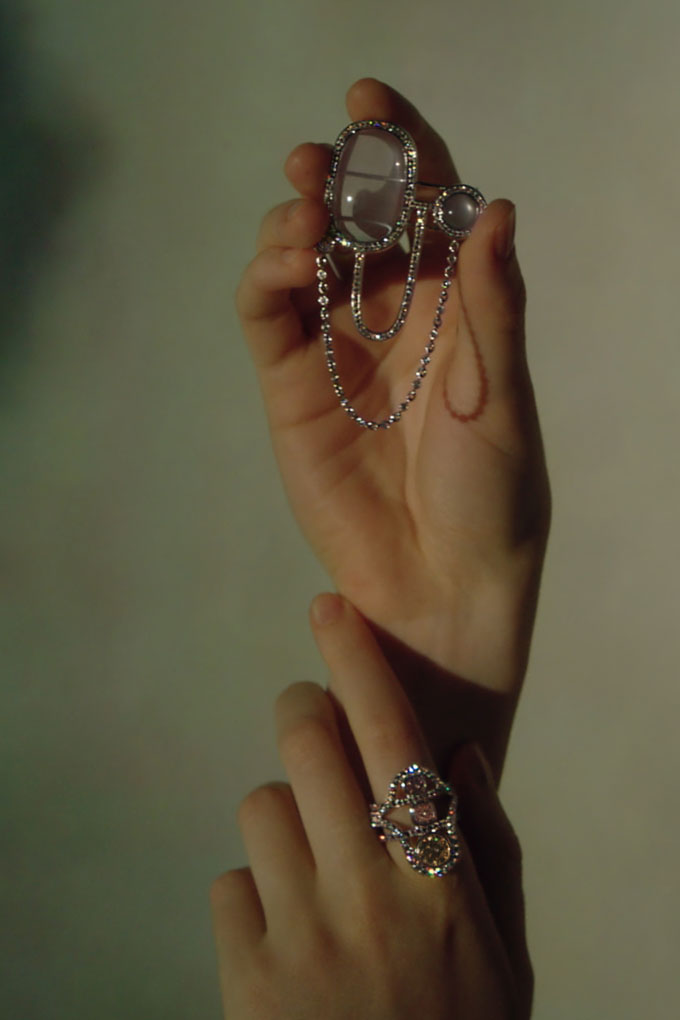As dramatic and lavish as the pieces are, Hermès Lignes Sensibles isn’t at all what we’d usually expect of a high jewellery collection. The focus isn’t so much on the preciousness of the stones, or the goldsmithing, or even the design—as is typically the case with traditional high jewellery.
But Hermès is never plainly traditional, even as the maison is one of the leading bastions of classic French values. And so when it comes to high jewellery, it strives constantly to bring something bold and brave to the table.
Conceived and conceptualised by Hermès’ creative director for jewellery, Pierre Hardy, Hermès Lignes Sensibles is a strong departure from the maison’s earlier, inaugural, high jewellery collection, Enchaînements Libres. That was where the designer sought to create as many radical permutations of the house emblem, the chaîne d’ancre, as possible.

With Hermès Lignes Sensibles, however, Hardy undertook an inwardly journey instead, contemplating the human body, its sensations, emotions, its textures and forms, colour palette, and even the way we move.
Vogue Singapore spoke with Hardy in a virtual conference as soon as the collection was launched, to discover more about his creative journey.

The human anatomy feels like a very specific point of inspiration for Hermès Lignes Sensible. What occupied your mind as you created the pieces?
I tried to stay as close as possible to the body. To think about this very specific relationship that happens when a woman chooses to wear a piece of jewellery, and trying to understand and express this moment, this sensibility. It’s a pleasure, of course. There’s a pleasure you try to express for others, a social moment, but most of this feeling is about yourself and how you perceive the interaction between jewellery and yourself. That’s the main reason why you love it. Or not.
Hermès Lignes Sensibles also departs from the traditional aesthetic for classical high jewellery…
High jewellery is a very historical and achieved field of emotion because it comes from a time where pieces were worn out of specific moments by specific people like royalty aristocracy. Then came couture, then ceremonies, then occasions… We don’t live in this way anymore. Especially at Hermès. The Hermès woman is not like that. When I think about jewellery I try to think about now, and what women want to wear now. And how they want to wear. Why they want to wear. It’s not for others, it’s not to be photographed, it’s not to be in representation, not for social duty. It’s because of themselves, because they need, because they love it. It’s very different from what it used to be. That’s why I try to find new way to express it.

Do you see it as a duty by Hermès to bring something new to the high jewellery table?
It’s funny because Hermès is sometimes even considered a fantasy for people who are very traditional or classical. The history of Hermès is marked by discovering an innovative gesture. Let’s take equestrianism as an example. It was a big deal in the 19th century to make harnesses as light as possible, as discreet, as efficient as possible. The main ideas were to reduce the amount of material and the weight of it… Now Hermès is a traditional maison but we’re exactly the contrary. And maybe it’s too ambitious [of me] but I try to do the same to jewellery. To find new solutions instead of existing ways.
The human anatomy was the inspiration for this collection. Now, how did you go about doing the research for this?
[Laughs] I must say that for this collection, the research process was very intimate, asking some really fundamental questions about this relationship between woman and jewellery. A very precise perception of what I want on my skin. Trying to draw the lines that could express this passage from inside to outside. So there are no external images in had in mind. It was however quite fundamental to make the pieces as sensual and seductive as possible. Like when you write a text. You’re telling a story and you want to tell it as precisely as possible. I want to show you what’s happening when a piece of jewellery is on the skin, on the body, and look how beautiful it is, how feminine and essential it can be. Not only how bright or big or heavy it is, but on the contrary, how it can merge and fuse with the body.

Tell us more about the making of the Contre La Peau necklace.
It was fun and weird at the same time. We were searching for a structure that could follow the skin, and we achieved a construct that was like a second skin. When you look at it, it looks exactly like skin placed under a magnifier. Triangle links allow it to be very movable with no limit in any direction.
Why did you go all the way and create a new chain design with the triangular links, rather than use a pre-existing technique?
You know the famous Da Vinci Vitruvian Man. It is a structure and we’re all made of this sketch but at the same time we’re different. The aim was to show all these slight differences we have in our structure. At the end, there was also the DNA genetic chain, cells, patterns that are beautiful inside of us, which we don’t see and we’re not conscious of them all the time. But they’re inside of us. So from tiniest most invisible things, to most external and visible ones, we’re built with pattern and geometry. And at same time we all escape from this pattern, we all express it in different ways.

The collection also uses stones selected for their proximity to colours of eyes and skin, their shapes also smooth and subtly facetted, rather than bright and hard and shiny…
I’m trying to express proximity to skin. It’s like you’re choosing words when speaking, like choosing a way to express your feeling. The necklaces, they’re like a thrill, a smile on your lips, a tear on your face, a tear of pleasure, or sadness, joy, emotion… something very subtle. There’s no weight on it, very soft, discreet but also very strong and very deep inside. I wanted the stones to reflect all these variation of feelings, sensations, and perceptions.
Do you think of high jewellery as exclusively feminine?
It used to be true. But you know how blurry the limit has become between masculinity and femininity. I think it’s a continuous ebb and flow. I spent my youth in 70s, and the 70s were the most unisex of moments. I used to have long hair, I liked wearing fur and high-heeled boots, velvet and things like that. It was not about femininity, it was just like this. Youth was like this. It wasn’t even about being provocative, that’s just who we were. I think it will be like this again. I don’t know if it will last forever. Because fashion and all these questions on gender masculinity versus femininity depends on what’s happening around us. In society. Not only about fashion. It’s about what society is able to accept or not.

And specific to high jewellery?
I find it very touching when I see a guy wearing his girlfriend’s ring, maybe an earring or even a necklace. I think there is a sentimental meaning in jewellery.
Have any of your colleagues in the jewellery world found your views perplexing?
They’re used to it now! [Laughs] They know me and also I think because high jewellery is a luxurious and sophisticate object, it has to be surprising at least. Not disturbing, because you still have to wear it and to carry it in a way. But it has to be very different than all the rest of what is existing. That’s the minimum it has to be. If you’re repeating again and again, then why should customers pay this for this object? It has to be a questioning sometimes. In the right place. Not disturbing, but questioning a little bit.





